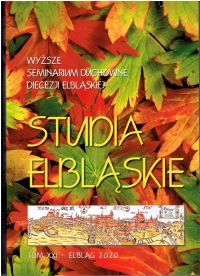Kaplica biskupa Krzysztofa Andrzeja Jana Szembeka we Fromborku i jej dekoracja malarska z pierwszej połowy XVIII wieku
The Chapel of Bishop Krzysztof Andrzej Jan Szembek in Frombork and its painting decorations from the first half of the 18th century
Author(s): Szymon TraczSubject(s): Christian Theology and Religion, History, Fine Arts / Performing Arts, Cultural history, Architecture, History of Church(es), Theology and Religion, History of Art
Published by: Wyższe Seminarium Duchowne Diecezji Elbląskiej w Elblągu
Keywords: reliquary chapel; oratorio; Frombork; Diocese of Warmia; Bishop Krzysztof Andrzej Jan Szembek; square; polychrome; Maciej Jan Meyer
Summary/Abstract: A chapel under the invocation of the Most Holy Saviour and St. Theodore the Martyr (Theodor of Amasea), known as Szembek Chapel was founded by the Bishop of Warmia, Krzysztof Andrzej Jan Szembek of Słupów (1680 – 1740), a bishop of Warmia in 1724 – 1740. The oratory is an example of a central dome structure. It was established as a reliquary chapel and a burial place for its founder. The central point of the chapel is the reliquary reredos,placed in the southern arcade in 1734. On the altar mensa there is a sarcophagus with visors and silver applications with the relics of St. Theodore of Amasea. It is accompanied by numerous relics of various saints and Agnus Dei of wax placed in black, wooden, glass reliquaries, richly decorated with trimmed silver applications. Their silver fittings and decorations were made in the years 1730 – 1743 by a goldsmith from Olsztyn – Jan Krzysztof Geese (†1761) and Samuel Grewe (1712 – 1750), a goldsmith from Królewiec. The entire interior of the chapel is covered with frescoes made around 1735 by Maciej Jan Meyer (Matthias Johann Meyer) from Lidzbark Warmiński. The artist decorated the pilasters, friezes and panelsof the chapel’s walls with forms of marbling and regency ornamentation. In the corners of the chapel there are four pairs of pilasters. For every pair, between the pilasters, there are medallions with busts of saints. Additionally, in the arcade above the entrance to the oratory, Meyer portrayed a monumental Vision of St. Theodore of Amasea. In the arches of the arcades, hepresented personifications of eight blessings, painted in the en grisaille technique. Finally, in the the dome of the chapel one can admire adoration of the Holy Trinity and the Holy Cross by the inhabitants of Heaven, led by the Assumed Virgin Mary. The painting decoration of Szembek Chapel, rich in ideological content, is an early example of Polish quadrature illusionist painting that draws abundantly from the Italian painting tradition inspired by Andrea Pozzo (1642 – 1709). Educated in Italy, Meyer, while composing the dome decorations, drew inspiration from frescoes from the years 1664 – 1665 by Pietro Berrettini da Cortona in the dome of Santa Maria in Valicella in Rome. In case of the arragmenet of the painted medallions with busts that can be found in the lower part of the chapel, Meyer was influenced bya solution used in the side axes of the main altar from the years 1699 – 1700 in the Church of the Holy Cross in Warsaw funded by Meyer’s patron, Bishop Teodor Potocki, a direct predecessor of Bishop Szembek of Warmia.
Journal: Studia Elbląskie
- Issue Year: 2020
- Issue No: 21
- Page Range: 63-90
- Page Count: 28
- Language: Polish

